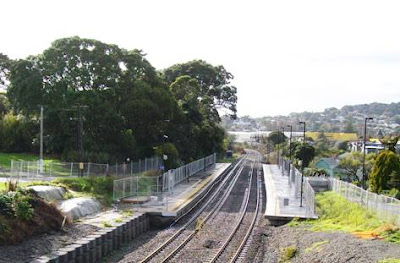Something I've been meaning to do since starting Timespanner back in '08 is to visit Titirangi Village (I called it Titirangi township, but was told by the proprietor of Gone West Books -- a nice bloke to have a bit of a yarn with on a Thursday afternoon with a wonderful if tempting bookstore -- said the locals prefer the term "village", so I stood corrected). I wasn't sure just what I could find there to put up on the blog, actually. Titirangi is your usual suburban service centre these days. Still, worth the look around while I was between appointments.
Poor Henry Atkinson. His statue struck me from this angle as having a most woebegone expression. From a booklet I helped put together earlier this year for the West Auckland Historical Society:
Born in 1838, Henry Atkinson served as an engineer for the Auckland Gas Company. On retirement, he bought land and built a homestead on South Titirangi Road (since demolished). A family holiday home he built in 1915 is still in existence. He donated part of his Waitakeres land to Auckland City Council.
Apparently, the statue originally stood on Mt. Atkinson, facing his former home, as he requested. But -- after vandals stole the nose, the statue was removed and relocated here, outside Lopdell House. It's been got at even here, so I understand. No wonder he's looking so sad. More info here and here.
Then, there's Lopdell House.
Again, from the booklet:
The “Hotel Titirangi” was completed in 1930 and opened by the Prime Minister, Gordon Coates on 20 November. It catered for 63 guests with fully carpeted rooms, drive-in garaging, and included a small shop, tea room and restaurant. The one main thing it lacked was a liquor license, which it was never granted. It continued with declining fortunes as a hotel until 1942 when it was sold to the Ministry of Education as a school for the deaf. In 1960 the building became a residential centre for teachers, and was renamed “Frank Lopdell House”, after a former Principal of Auckland Teachers College. It was bought by Waitemata City Council in 1983 to become an arts and cultural centre for West Auckland.
I did some research for WAHS' newsletter in April this year on Lopdell House's designer, William Swanson Read Bloomfield, of the partnership (1929-1934) of Bloomfield, Owen and Morgan, who was the first known qualified architect practicing in New Zealand of Maori descent. He was the grandson of William Swanson and Ani Rangitunoa. Born in Gisborne, he studied in England, on the European Continent, and also the University of Pennsylvania, USA. During World War I he served as Captain in the Royal Flying Corps, 57 Squadron, and was shot down behind enemy lines in 1917, serving time as a prisoner of war in Germany until the end of hostilities. In November 1929, he married Rhoda Gribbin at Holy Trinity Church in Devonport. During the 1920s, he became a foundation member of the Auckland Aero Club.
He practiced in Auckland from the mid 1920s until his retirement in 1959, either in sole practice or with a number of partnerships.
In 1954, Home & Building published a brief biography on Bloomfield, in which it was stated he was “interested in early English and Chinese china, old Italian bronzes, and water colours.” An undated thesis of his still survives in the School of Architecture records: at the University of Auckland “The Structural Development of the Early Christian Basilica to Amiens Cathedral”.
His ashes were interned at Purewa Cemetery in 1969.
Can't forget Titirangi's sculpture, though.
From the booklet:
This is one of the Waitakere's distinctive landmarks and is perhaps one of our more controversial works of art. It was the winning concept in a competition for young design students. Artist Lisa Higgens enlarged her jewellery designs, inspired by lichen and algae, and these organic shapes evolved representing the regeneration of life. It was fashioned at Unitec.
But what of street art? Well, I found a bit up in the village proper.
The real gems I found, though, will have to be in the next post.






























































